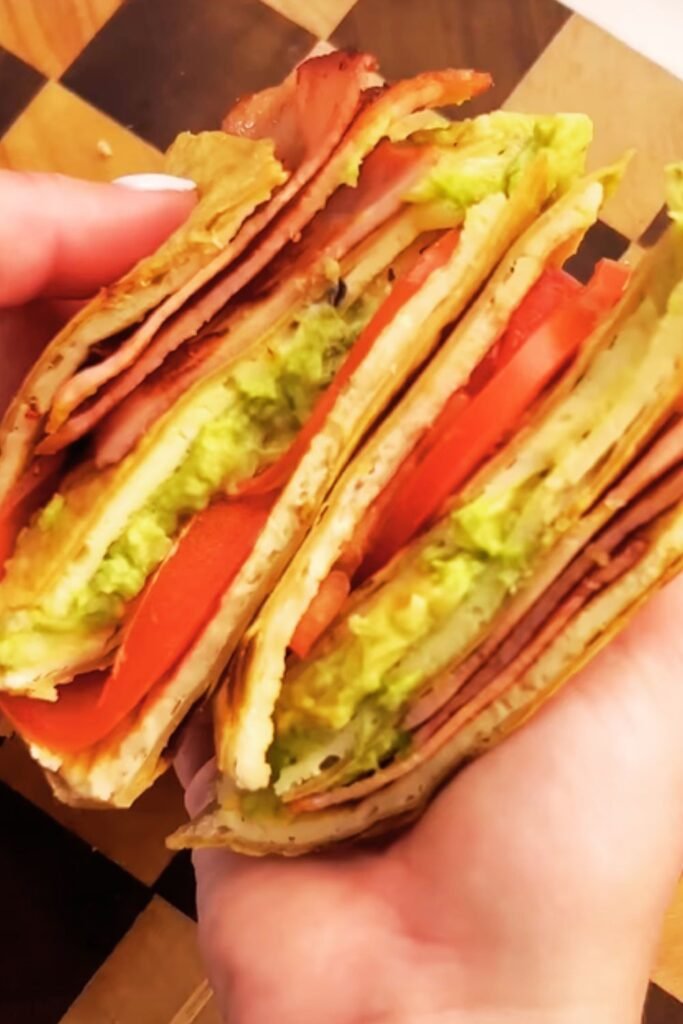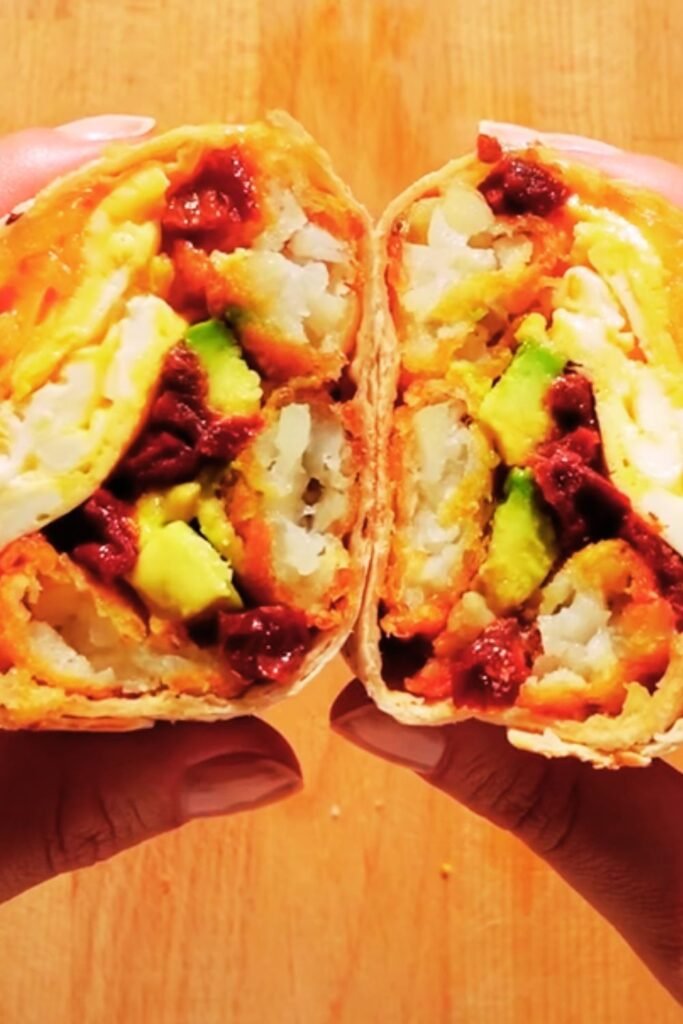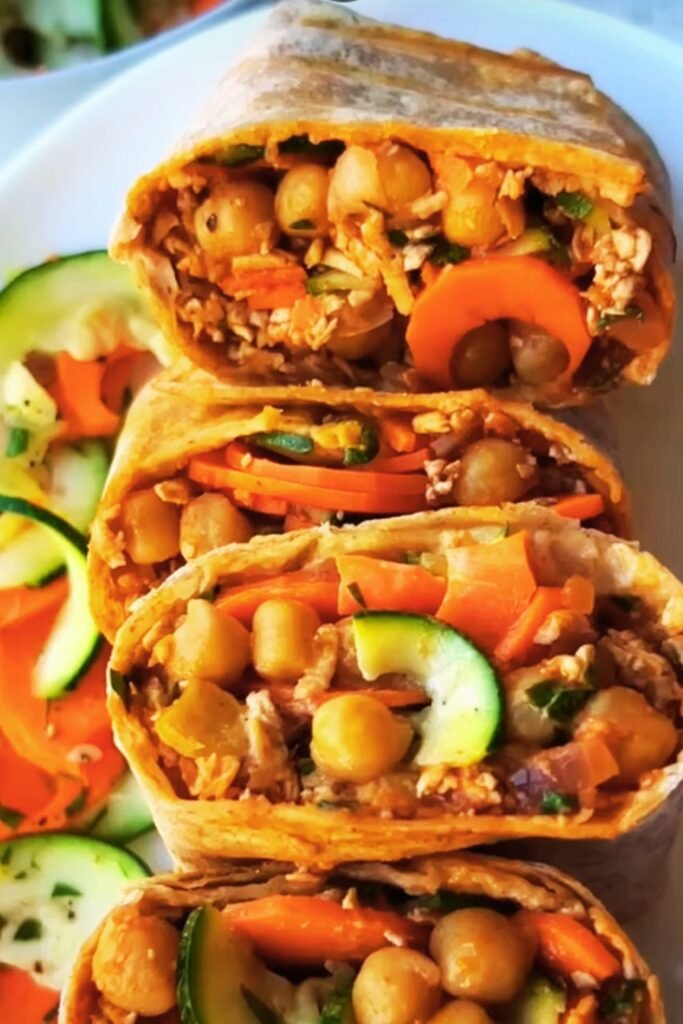Starting my day with a nutritious, flavorful breakfast has become one of my non-negotiables, and nothing quite hits the spot like a perfectly crafted breakfast veggie wrap. I’ve discovered that these colorful, nutrient-packed bundles of goodness aren’t just Instagram-worthy – they’re genuinely game-changing for anyone looking to fuel their morning with intention and flavor.
After years of experimenting with countless breakfast combinations, I can confidently say that veggie wraps have revolutionized my morning routine. They’re portable, customizable, and packed with the vitamins and minerals my body craves first thing in the morning. Whether I’m rushing out the door for an early meeting or enjoying a leisurely weekend brunch, these wraps deliver consistent satisfaction and sustained energy.
Why I’m Obsessed with Breakfast Veggie Wraps
My journey with breakfast veggie wraps began when I realized I was stuck in a boring cereal-and-toast routine that left me hungry by 10 AM. I needed something that would keep me satisfied, provide genuine nutrition, and still taste absolutely delicious. These wraps checked every single box.
What I love most about breakfast veggie wraps is their incredible versatility. I can prep components ahead of time, customize them based on what’s in my refrigerator, and create endless flavor combinations that never get boring. They’ve become my canvas for experimenting with seasonal vegetables, different protein sources, and exciting sauce combinations.
The nutritional benefits are simply outstanding. By packing my wraps with colorful vegetables, I’m starting my day with a rainbow of antioxidants, fiber, and essential nutrients. This approach has dramatically improved my energy levels throughout the morning and helped me maintain better eating habits all day long.
Essential Ingredients for Perfect Breakfast Veggie Wraps
Creating exceptional breakfast veggie wraps starts with selecting high-quality ingredients. I’ve learned that freshness makes all the difference, and having the right components on hand ensures I can whip up a satisfying wrap any morning.
Base Wraps and Tortillas
Whole Wheat Tortillas: My go-to choice for their nutty flavor and higher fiber content. They provide excellent structure and hold ingredients beautifully without tearing.
Spinach Tortillas: These add an extra boost of nutrients and create an appealing green color that makes the wrap even more appetizing.
Gluten-Free Options: For those with dietary restrictions, I recommend almond flour or cassava-based wraps, which offer great texture and flexibility.
Large Flour Tortillas: When I want something more substantial, these provide ample space for generous fillings.
Protein Powerhouses
Including quality protein in my breakfast wraps ensures sustained energy and helps me feel satisfied until lunch. Here are my favorite options:
Scrambled Eggs: The classic choice that provides complete protein and creamy texture. I prefer cooking them slightly underdone so they don’t become rubbery when reheated.
Greek Yogurt: This adds protein and beneficial probiotics while creating a creamy base for other flavors.
Hummus: A plant-based protein that brings Mediterranean flavors and satisfying richness.
Black Beans: Fiber-rich and protein-packed, they add heartiness and work beautifully with southwestern flavors.
Tofu Scramble: My favorite vegan option that absorbs flavors wonderfully and provides excellent texture contrast.

Vegetable Stars
The vegetables are truly the stars of these wraps, providing color, crunch, and incredible nutritional value. I always aim for variety in both color and texture.
Bell Peppers: Sweet, crunchy, and available in multiple colors, they add vibrant appeal and vitamin C.
Spinach: Packed with iron and folate, it wilts beautifully and adds earthy flavor without overwhelming other ingredients.
Mushrooms: I love sautéing them until golden for deep, umami-rich flavor that makes wraps more satisfying.
Avocado: Creamy texture and healthy fats make this ingredient essential for both flavor and nutrition.
Red Onion: Thinly sliced, it provides sharp flavor contrast and beautiful color.
Cherry Tomatoes: Burst of freshness and acidity that brightens the entire wrap.
Cucumber: Adds refreshing crunch and helps balance richer ingredients.
Shredded Carrots: Natural sweetness and satisfying crunch that works in almost any flavor combination.
My Foolproof Preparation Method
After making hundreds of breakfast veggie wraps, I’ve developed a systematic approach that ensures consistently delicious results every time.
Step-by-Step Assembly Process
- Warm the tortilla gently in a dry skillet for 15-20 seconds on each side. This makes it more pliable and enhances flavor.
- Apply the base spread in a thin, even layer, leaving about an inch border around the edges. This prevents ingredients from sliding around.
- Layer proteins strategically in the center third of the tortilla, creating a foundation for other ingredients.
- Add vegetables thoughtfully, placing heavier items like roasted peppers closer to the protein and lighter items like greens toward the edges.
- Season judiciously with salt, pepper, and any preferred spices while ingredients are still visible.
- Fold with confidence by bringing the bottom edge up and over the filling, tucking it under, then folding in the sides before rolling tightly.
Temperature and Timing Considerations
I’ve learned that temperature control is crucial for wrap success. Room temperature ingredients blend harmoniously, while hot ingredients can make tortillas soggy. I let cooked components cool for about 5 minutes before assembly, which also prevents wilting delicate greens.
Timing is equally important. I assemble wraps just before eating for optimal texture, though meal-prepped components can be stored separately and assembled quickly when needed.
Nutritional Breakdown and Health Benefits
Understanding the nutritional profile of breakfast veggie wraps helps me appreciate why they’ve become such an important part of my morning routine.
| Nutrient Category | Primary Sources | Benefits |
|---|---|---|
| Protein | Eggs, Greek yogurt, beans, hummus | Sustained energy, muscle maintenance, satiety |
| Fiber | Whole wheat tortilla, vegetables, beans | Digestive health, blood sugar stability, fullness |
| Healthy Fats | Avocado, olive oil, nuts/seeds | Brain function, nutrient absorption, hormone production |
| Vitamin C | Bell peppers, tomatoes, leafy greens | Immune support, collagen synthesis, iron absorption |
| Folate | Spinach, beans, fortified tortillas | DNA synthesis, red blood cell formation, pregnancy health |
| Potassium | Avocado, mushrooms, tomatoes | Heart health, blood pressure regulation, muscle function |
| Antioxidants | Colorful vegetables, herbs | Cellular protection, inflammation reduction, disease prevention |
Caloric and Macronutrient Profile
A typical breakfast veggie wrap I make contains approximately:
- Calories: 350-450
- Protein: 15-25 grams
- Carbohydrates: 35-45 grams
- Fat: 12-18 grams
- Fiber: 8-12 grams
This balanced macronutrient profile provides steady energy release and helps me maintain stable blood sugar levels throughout the morning.
Flavor Variations I Love
One of the aspects I enjoy most about breakfast veggie wraps is experimenting with different flavor profiles. Here are my favorite combinations that never fail to excite my taste buds.

Mediterranean Morning Wrap
This combination transports me to a sunny Greek island every morning. I spread hummus as the base, add scrambled eggs with crumbled feta, diced cucumbers, cherry tomatoes, red onion, and fresh spinach. A sprinkle of oregano and a drizzle of olive oil complete this Mediterranean masterpiece.
The flavors work harmoniously together – the tangy feta balances the creamy hummus, while the crisp vegetables provide textural contrast. This wrap is particularly high in protein and provides excellent hydration from the cucumber and tomatoes.
Southwest Fiesta Wrap
When I crave bold, spicy flavors, this combination never disappoints. I start with Greek yogurt mixed with lime juice and cumin, add scrambled eggs with jalapeños, black beans, diced bell peppers, avocado, and cilantro. A pinch of smoked paprika adds depth.
This wrap delivers complex flavors with layers of heat, creaminess, and freshness. The combination of beans and eggs provides complete protein, while the avocado adds satisfying healthy fats.
Green Goddess Wrap
Perfect for days when I want maximum vegetable intake, this wrap features spinach tortilla, avocado spread, tofu scramble with turmeric, sautéed mushrooms, spinach, cucumber, and sprouts. Fresh herbs like basil or cilantro elevate the freshness factor.
This plant-based option is incredibly nutrient-dense and provides sustained energy without feeling heavy. The turmeric in the tofu scramble adds anti-inflammatory benefits.
Italian Herb Garden Wrap
Inspired by classic Italian flavors, I spread pesto as the base, add scrambled eggs with sun-dried tomatoes, roasted red peppers, fresh mozzarella, arugula, and fresh basil. A crack of black pepper completes this sophisticated combination.
The pesto provides healthy fats and intense flavor, while the fresh herbs add aromatic complexity. This wrap feels indulgent while remaining nutritionally balanced.
Meal Prep Strategies That Work
Meal prepping breakfast veggie wraps has been a game-changer for my busy mornings. I’ve developed systems that maintain freshness while saving precious time during hectic weekday rushes.
Component Preparation Method
Rather than assembling complete wraps in advance, I prep individual components that can be quickly combined:
Proteins: I cook scrambled eggs slightly underdone and store them in the refrigerator for up to 3 days. Greek yogurt-based spreads keep for up to a week when stored properly.
Vegetables: I wash, chop, and store vegetables in airtight containers with paper towels to absorb excess moisture. Most prepared vegetables stay fresh for 3-5 days.
Sauces and Spreads: Homemade hummus, pesto, and yogurt-based sauces can be prepared in larger batches and stored for up to a week.
Assembly-Line Approach
On Sunday evenings, I set up an assembly line with all components arranged in order. This allows me to quickly customize wraps based on daily preferences while maintaining efficiency.
I store tortillas in the refrigerator and warm them quickly in a dry skillet each morning. This extra step makes an enormous difference in texture and prevents cracking during assembly.
Storage and Reheating Guidelines
Proper storage techniques ensure my breakfast veggie wraps maintain optimal flavor and texture when prepared in advance.
| Storage Method | Timeline | Best Practices |
|---|---|---|
| Refrigerated Wraps | 1-2 days | Wrap tightly in plastic wrap or foil, store in airtight container |
| Component Storage | 3-5 days | Store each component separately in airtight containers |
| Frozen Wraps | Up to 1 month | Wrap individually in plastic wrap, then place in freezer bags |
| Reheating Method | As needed | Microwave for 30-60 seconds or toast in skillet until warmed through |
Preventing Sogginess
The key to maintaining wrap integrity is moisture control. I avoid adding wet ingredients like fresh tomatoes directly to make-ahead wraps. Instead, I pack them separately and add during assembly or eating.
Paper towels placed between wet ingredients and the tortilla create an effective moisture barrier. This simple technique has eliminated soggy wrap disasters from my meal prep routine.
Troubleshooting Common Issues
Through trial and error, I’ve identified solutions to the most common breakfast veggie wrap challenges.
Tearing Tortillas: Always warm tortillas before assembly and avoid overfilling. If tears occur, I patch them with small pieces of tortilla and continue rolling.
Sliding Ingredients: Creating a thin layer of spread acts as edible glue that holds ingredients in place. I also avoid smooth, round ingredients that tend to roll out.
Bland Flavors: Season each component individually rather than relying on a single sauce. Salt enhances natural vegetable flavors dramatically.
Uneven Heating: When reheating, I cover wraps with a damp paper towel to create steam, which heats ingredients evenly without drying out tortillas.

Serving Suggestions and Accompaniments
While breakfast veggie wraps are complete meals on their own, certain accompaniments enhance the overall eating experience and provide additional nutrition.
Fresh Fruit Pairings
I love serving wraps with seasonal fresh fruit that complements the flavors:
- Berries: Their natural tartness balances rich, creamy wrap ingredients
- Citrus segments: Add brightness and vitamin C while cleansing the palate
- Apple slices: Provide satisfying crunch and natural sweetness
- Melon: Offers hydrating freshness that pairs beautifully with savory wraps
Healthy Beverage Combinations
The right beverage can enhance both flavor and nutrition:
- Fresh vegetable juice: Doubles down on morning vegetable intake
- Herbal teas: Provide gentle caffeine and complementary flavors
- Coconut water: Offers natural electrolytes and subtle sweetness
- Green smoothies: Create a complete, nutrition-packed breakfast experience
Light Side Dishes
For particularly hungry mornings or when entertaining, these sides work wonderfully:
- Roasted sweet potato wedges: Add natural sweetness and additional fiber
- Mixed green salad: Provides extra vegetables and textural variety
- Yogurt parfait: Offers probiotics and satisfying protein
- Homemade granola: Adds satisfying crunch and healthy fats
Seasonal Adaptations
Adapting breakfast veggie wraps to seasonal ingredients keeps them exciting year-round and ensures peak flavor and nutrition.
Spring Inspiration
Spring vegetables bring fresh, delicate flavors that feel rejuvenating after winter. I incorporate asparagus, peas, fresh herbs, and early greens that provide natural detoxification support.
Asparagus adds elegant flavor and natural diuretic properties, while fresh peas contribute sweetness and plant-based protein. Spring onions provide mild flavor that doesn’t overpower delicate seasonal vegetables.
Summer Abundance
Summer’s bounty allows for the most colorful, hydrating wraps imaginable. Tomatoes, cucumbers, fresh herbs, and summer squash create refreshing combinations perfect for hot mornings.
I love using fresh corn kernels that add natural sweetness and satisfying pop. Cherry tomatoes provide juicy bursts of flavor, while fresh basil and cilantro add aromatic complexity.
Autumn Comfort
Fall vegetables bring heartier flavors and warming properties. Roasted butternut squash, caramelized onions, and hardy greens like kale create satisfying, comforting wraps.
Apple slices add unexpected sweetness that pairs beautifully with savory ingredients, while roasted peppers provide deep, smoky flavors that evoke cozy autumn mornings.
Winter Warmth
Winter calls for ingredients that provide internal warmth and immune support. I incorporate roasted root vegetables, warming spices, and preserved elements that add complex flavors.
Roasted beets add earthy sweetness and vibrant color, while winter squash provides natural creaminess and beta-carotene. Warming spices like turmeric and ginger support immune function during cold months.
Quality Ingredient Selection Tips
Selecting the highest quality ingredients makes a noticeable difference in both flavor and nutrition. I’ve learned to identify signs of freshness and quality that elevate every wrap.
Choosing Perfect Produce
Visual Inspection: I look for vibrant colors, firm textures, and absence of dark spots or wilting. Fresh vegetables should look alive and appealing.
Seasonal Shopping: Buying vegetables in season ensures peak flavor, optimal nutrition, and better prices. I plan my wrap varieties around what’s currently at its best.
Local Sourcing: When possible, I choose locally grown produce that hasn’t traveled long distances. This often means better flavor and higher nutrient content.
Organic Priorities: For the “Dirty Dozen” vegetables that tend to have higher pesticide residues, I prioritize organic options when budget allows.
Protein Quality Matters
Egg Selection: I choose pasture-raised eggs when possible for their superior flavor and nutrient profile, including higher omega-3 content.
Dairy Choices: Full-fat Greek yogurt provides better satiety and flavor than low-fat versions, while also offering superior texture in wraps.
Plant Proteins: I look for organic, minimally processed options like sprouted tofu or beans cooked from scratch when time permits.
Questions and Answers
Q: How far in advance can I prepare breakfast veggie wraps?
I recommend preparing components up to 3 days ahead, but assembling wraps no more than 1-2 days before eating. This prevents sogginess while maintaining food safety. For best results, I store components separately and assemble fresh each morning.
Q: What’s the best way to prevent my wraps from getting soggy?
The key is moisture control. I pat all vegetables dry before assembly, use paper towels to absorb excess moisture, and avoid adding very wet ingredients like fresh tomatoes to make-ahead wraps. Storing wet and dry components separately until assembly prevents sogginess.
Q: Can I freeze breakfast veggie wraps?
Yes, but with some limitations. I freeze wraps without fresh vegetables like lettuce or tomatoes, which become watery when thawed. Frozen wraps keep for up to one month and reheat well in the microwave or toaster oven. I wrap them individually in plastic wrap before freezing.
Q: How do I make my wraps more filling without adding too many calories?
I focus on high-fiber vegetables like leafy greens and bell peppers, which add volume without many calories. Protein sources like eggs or Greek yogurt provide satiety, while a small amount of healthy fats from avocado keeps me satisfied longer.
Q: What tortilla alternatives work best for those avoiding gluten?
My favorite gluten-free options include almond flour tortillas, coconut wraps, or large lettuce leaves for a very low-carb option. Corn tortillas work well for smaller wraps, though they’re less flexible than wheat alternatives.
Q: How can I add more protein to vegetarian breakfast wraps?
I layer multiple protein sources: Greek yogurt as a base, scrambled eggs or tofu scramble, and beans or hummus. Hemp seeds or chia seeds sprinkled throughout add protein and healthy fats. Cheese also contributes protein while adding flavor.
Q: What’s the ideal wrap-to-filling ratio?
I aim for about 3/4 cup of filling per large tortilla. This provides enough ingredients for satisfying flavor and nutrition without overstuffing, which makes rolling difficult and eating messy.
Q: How do I reheat frozen breakfast wraps for best results?
I thaw frozen wraps in the refrigerator overnight, then reheat in a covered skillet over medium-low heat for 2-3 minutes per side. This method prevents the tortilla from drying out while ensuring ingredients heat evenly throughout.
Q: Can I meal prep breakfast wraps for the entire week?
While components keep well for 5-7 days, I don’t recommend assembling wraps more than 2 days ahead due to quality degradation. Instead, I prep all components on Sunday and quickly assemble fresh wraps each morning – it only takes 2-3 minutes.
Q: What herbs and spices work best in breakfast veggie wraps?
My go-to seasonings include fresh herbs like cilantro, basil, and parsley, which add brightness without overwhelming other flavors. For spices, I love cumin, smoked paprika, turmeric, and everything bagel seasoning. Salt and fresh black pepper enhance natural vegetable flavors significantly.
Breakfast veggie wraps have truly transformed my morning routine, providing the perfect combination of nutrition, flavor, and convenience. They’ve helped me start each day with intention and energy, while satisfying my creative desire to experiment with new flavor combinations. Whether you’re a busy professional, a health-conscious parent, or someone simply looking to upgrade your breakfast game, these versatile wraps offer endless possibilities for morning nutrition perfection.